
Ayurvedic and Herbal
Ayurvedic and herbal practices focus on natural healing using plant-based remedies. Ayurvedic medicine, rooted in ancient Indian traditions, emphasizes balance in the body through diet, lifestyle, and herbal treatments. Herbal medicine utilizes the therapeutic properties of plants to treat various ailments, promoting overall well-being. Both approaches aim for holistic health and prevention.
Paspanguwa
The ‘Paspanguwa’ (පස් පංගුව) traditional medicinal formula can be obtained as air-tight sachets or packets as an over-the counter medicine in pharmacies and supermarkets. The ailments, for which this can be used as per the instructions in the packaging, are colds, coughs, headaches, fever, and overall body aches. Although the herbal formulation itself has not been clinically evaluated, its constituents possess significant evidence as to their respective efficacies against a myriad of disease conditions. ‘Paspanguwa’ is commonly consumed as an herbal tea preparation. The name, which means five portions in the vernacular language of Sinhala, is made by the combination of five main herbs. The five ingredients, which make up the formula commonly, consist of Ginger (Zingiber officinale), ‘Pathpadagam’ (Hedyotis corymbosa),
‘Katuwalbatu’ (Solanum xanthocarpum), ‘Veniwalgata’ (Coscinium fenestratum) and Coriander (Coriandrum sativum). In some instances other herbs such as ‘Thippili’ (Piper longum), Thai eggplant (Solanum melongena), Black pepper (Piper nigrum), Wishnukranthiya (Evolvulus alsinoides) and Pawatta (Justicia adhatoda) may also be used. Figure 1 shows a commercially available ‘paspanguwa’ package, and the ingredients used. The resulting herbal tea from this decoction is bitter in taste, thus, it is often taken together with sugar or juggery. To date, there has been only one in vitro study performed to explore the antioxidant and starch hydrolyses inhibitory properties of one form of the ‘paspanguwa’ herbal formula . However, it should be noted that the major constituents in these herbsin this herbal formula have been systematically studied for their efficacy against a variety of ailments, thus it may be deemed reasonable to review existing scientific material on these individual herbs. Overall, the purpose of this review is to describe the formula assess the ‘paspanguwa’ herbal formula and its constituents and promote the argument whether scientific validation is truly required for traditional medicinal recipes, such as these, which have gained so much popularity even without the scientific rigor.
Therapeutic Effects of the Constituent Herbs of ohe ‘Paspanguwa’ Formula
As previously mentioned, there are five ‘major’ constituents in the ‘paspanguwa’ formula, followed by minor ones which are incorporated primarily to boost the strength and effectiveness of the major components. The ‘major’ herbs are those, which are considered to contain the highest ability to prevent ailments such as coughs, colds, fever, and body aches. The rest do not necessarily target these diseases; however, as per traditional medicinal records, they are able to prevent these ailments when used in combination with another ‘major’ herb, rather than in isolation (Figure 2).
| English (Sinhala) Name | Picture |
| Black Pepper | 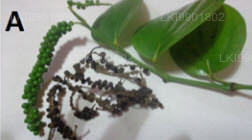 |
| Coriander seeds | 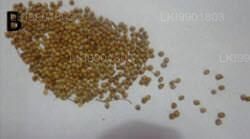 |
| Ginger plant with its rhizome | 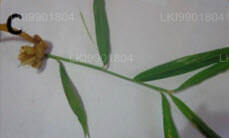 |
| Dried Katuwelbatu | 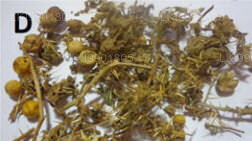 |
| Dried Pathpadagam | 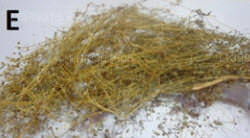 |
| Fresh leaves of Pawatta | 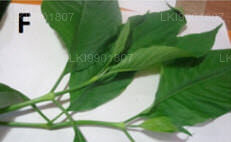 |
| Dried veniwelgata root bark | 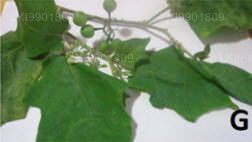 |
| Thai Eggplant | 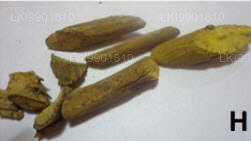 |
| Thai Eggplant |  |
Figure 2: Images of the major and minor ingredients used for the preparation of the ‘paspanguwa’: (A) Black Pepper (B) Coriander seeds (C) Ginger plant with its rhizome (D) Dried Katuwelbatu (E) Dried Pathpadagam (F) Fresh leaves of Pawatta (G) Thai Eggplant (H) Dried veniwelgata root bark (I) Vishnukranthiya plant.
Ginger (Zingiber officinale)
Ginger rhizomes are commonly used as a spice for preparing baked products, soups, pickles, puddings, and fermented beverages such as beer. In addition, it is used to obtain essential oil and oleoresin, which are internationally commercialized for use in the food and pharmaceutical industries. In traditional medicinal the dried ginger rhizomes are widely used as a home remedy to act against diseases such as vomiting, nausea and morning sickness during pregnancy, and also are used in the treatment of heart attack and stroke. In Ayurveda, ginger is also mentioned as an appetiser and could be used as an ointment for pains and for the treatment of digestive disorders and arthritis. Due to the versatility of ginger and its usage in many ailments, it is known as a universal treatment. Dried ginger rhizomes, which have been pulverized into powder is one of the five major ingredients of the ‘paspanguwa’ formula.
Pathpadagam (Hedyotis corymbosa)
This is a very common medicinal herb used in traditional as well as modern medicinal systems throughout the world. The plant is used as a treatment for skin aliments, appendicitis, viral infections, acne, venomous bites and eye disease. A decoction of the aerial part of this plant is used in the treatment of diseases such as a cough, bronchitis, necrosis, leprosy, giddiness, jaundice and nervous depression . Additionally, the herb is also known to possess anti-inflammatory, antioxidant, hepato-protective and fever-reducing effects. The leaves of the plant are known to possess iridoid glucosides in the form of anthraquinones and triterpenoids . The leaves and stems of this herb are incorporated into the ‘paspanguwa’ recipe as one of the five major ingredients.
Katuwalbatu (Solanum xanthocarpum)
This herb is commonly used in the traditional medicinal system in Sri Lanka for a variety of ailments. It is known to contain a high amount of alkaloids and flavonoids . It is known for its anti-asthmatic, hepato protective, hypoglycemic, anti-inflammation, and anti hyperlipidemic properties and it is used for the treatment of fever, asthma, bronchitis, urinary disease, heart diseases and reduce and physical pain . Solasodine is the primary bioactive compound in S. xanthocarpum, which possesses the antipyretic property . Dried berries of this herb are incorporated into the ‘paspanguwa’ formula as one of the five major ingredients.
Veniwalgata(Coscinium fenestratum)
This is a flowering woody climber with a high amount of antioxidant, anti-diabetic and anti-cancer effects. Berberine is one of the major bioactive compounds found in the stem of C. fenestratum, which is known to possess a wide range of pharmacological activities. In addition, a small portion of protoberberine is also present . C. fenestratum which is commonly used in Western medicine as an anti-cancer , antioxidant , hypoglycemic and antibacterial agent . In the traditional ‘paspanguwa’ the dried stem of this plant is used as one of the five major ingredients.
Coriander (Coriandrum sativum)
Coriander is one of the most common herbs used in many traditional systems to treat many disorders. In traditional medicinal systems, coriander is given to reduce the pain of rheumatism by pounding the seeds and combining them with hot water to make a paste and applied topicallyon the affected area . The seeds are used for health attributes such as improving diseases related to the gastro-intestinal tract and diabetes . Al-Mofleh et al. have demonstrated that Coriander seed powder protects the gastric mucosa in rats from ethanol-induced damage and also inhibit the formation of ulcers in rats. Another study demonstrated that the extract made from Coriander seeds has been used as a protective agent for gastric mucosa. The powder of dried Coriander seeds is typically added to the ‘paspanguwa’ herbal formula as one of the five major ingredients.
Thippili’ (Piper longum)
P. longum is a medicinal herb commonly used in traditional medicine and has a distinct odor and a pungent bitter taste. It is known as a remedy against gonorrhea, menstrual pain, viral hepatitis, tuberculosis, chronic malaria, sleeping problems, chronic bronchitis, asthma, chronic gut-related pain paralysis of the tongue, diseases of the spleen, cough, tumors and arthritis. It is able to directly affect the central nervous system. In traditional Ayurvedic medicine, this is considered as a good rejuvenator. The dried fruit of P. longumis sometimes added to the ‘paspanguwa’ formulation, and is not considered as one of the five major ingredients but rather a complementary agent.
Thai eggplant (Solanum melongena)
Thai egg plant is cultivated worldwide as a vegetable crop and is rich in polyphenols. It is rich in other nutrients, essentially minerals and vitamins as well as proteins, riboflavin, thiamine iron, calcium, nicotinemide, carbohydrate, vitamin C, fibre, fat and carotenes. It is typically used in the treatment of skin infections, gonorrhea, diabetes, rheumatic disease and swollen joint pains. The dried vegetable is sometimes added to the ‘paspanguwa’ herbal formula as a complementary boosting agent.
Black pepper (Piper nigrum)
P. nigrum is a widely used spice, consisting of piperine as the main bioactive compound. Other biologically active compounds in P. nigrum include monoterpenes, sesquiterpenes, curcumin and vasicine. It has immunomodulatory, anti-carcinogenic, anti-asthmatic, stimulatory, hepatoprotective, anti-inflammatory, antimicrobial spices, anti-ulcer activities, antioxidant and bio transformative effects, and is also known to enhance the absorption of drugs such as rifampicin, sulphadiazine, tetracyline, and phenytoin . In the Sri Lankan traditional medicinal system, P. nigrum is used to treat chills, rheumatism, flu, muscular aches, colds, exhaustion and fevers as well as to increase circulation of blood, increase the flow of saliva, stimulate the appetite, and to encourage peristalsis. P. nigrum is also used as a boosting agent in the ‘paspanguwa’ herbal formula.
Wishnukranthiya (Evolvulus alsinoides)
E. alsinoides is a medicinal herb, which is well documented in the Sri Lankan traditional medicinal system as having immunomodulatory, cytoprotective, adaptogenic, antiamnesic properties and antioxidant properties. This herb is used to promote adaptogenic, anti-phlogistic, antipyretic, antiseptic, aphrodisiac, febrifuge, stomachic, tonic and vermifuge effects. E. alsinoides is used as a supplementary herb in the ‘paspanguwa’ herbal formula.
Pawatta (Justicia adhatoda)
J. adhatoda is a medicinal shrub widespread throughout the tropical regions of South-East Asia. Its leaves and roots are commonly used in the Sri Lankan traditional medicinal system, which are known to possesstwo major alkaloids, vasicine and vasicinone along with some minor components such as vasicoline . The extract of the leaves of J. adhatoda has the ability to act as an anti-spasmodic, fever-reducing, anti-inflammatory, anti-bleeding, bronchodilatory, anti-diabetic, disinfectant, anti-jaundice, oxytocic and anti-helminticagent. In the traditional medicinal system of Sri Lanka, this is used to treat cold, cough, pneumonia, fever, jaundice, joint pain, catarrh, whooping cough, asthma and tuberculosis. Although J. adhatoda is used only as a supplementary herb in the ‘paspanguwa’ formula, it is used as the major ingredient in many other traditional medicinal recipes of Sri Lanka
Traditional Methods of Preparation and Consumption of the ‘Paspanguwa’
There are several ways of preparing the ‘paspanguwa’ by locals as well as by traditional medicinal practitioners, where in all methods, addition of water and heat is the most frequent way of obtaining the extract. Cold water may be added to the ingredients until boiling temperature is reached, or boiled water may be added to the ingredients and left in a closed container (typically, made from clay) for 10-15mins. The duration of boiling or exposure to boiled water may vary, mostly depending on the combination of ingredients used. The steam generated during the boiling process may also be used for inhalations to obtain relief from coughs and colds. The extract is recommended to be used at least 2-3 times per day, depending on the severity of the ailment. The traditional method of preparation has not been adequately documented and is passed down orally from one generation to another. Nevertheless, as one of the more ‘simpler’ forms of herbal formula in the traditional medicinal system of Sri Lanka, consultations with traditional medicinal practitioners revealed that the method of preparation does not vary all that much, other than the duration of boiling.
Quality of Preparation, Standards, and Dosages for Modern Times
One aspect of the ‘paspanguwa’ formula, if it were to be sent out to a global market, would be to enhance the quality of preparation, determine the standards and dosages a practice which has not been fully ascertained by modern day manufacturers of traditional medicines. The need for these aspects, especially Total Quality Management (TQM) has been emphasized in a recent publication by Cooper. While this paper focuses on Traditional Chinese Medicine (TCM), there is a need for all traditional medicinal systems to adapt to a more scientific means of verification, so that the health claims can be substantiated, including the ‘paspanguwa’ formula. Especially for Europe and the United States, acceptability of traditional herbal medicines requires evaluation of dosages to assure safety and efficacy. At this time, only a traditional medicinal practitioner’s word defines the currently accepted dosage of one ‘portion’ of each of the major herbs to varying amounts of the minor herbs, where ‘portion’ is simply a term of measurement of strength. For scientific investigations, researchers also need to bear in mind that the ‘paspanguwa’ formula is a combination of herbs, and thus, a reductionist approach may not work in fully determining its effectiveness. For this, modern advents such as use of a biomarker, linking a biological effect to a chemical marker and standardizing the levels of bio-actives, will go a long way to an improved quality product. Finally, newer processes such as systems biology, metabolomics and chemo metrics may be used to evaluate the biological responses of the formula more effectively, leading to a clinical trial.




